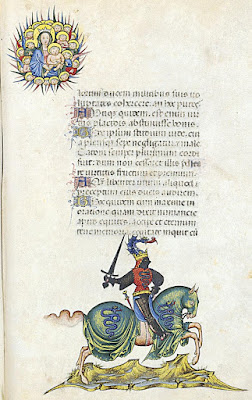Phaeded wrote: 06 Apr 2020, 00:15
I view that a little differently - Beatrice was a mistake, and if not a
damnatio memoriae at least a demonization of sorts was in order, thus the comparison with Dido. So on the flip side of that argument, would they have done that
pre-1418?[/quote
But I'll insist on that [Titus' magic spell] less than 1418. ;-)
Well, if you push in that direction, I'll have to push in the other, although I remain open minded for solid evidence that would exclude 1412.
As you have reminded us, Dido is not mentioned in DSH, it's only our interpretation that her presence is lurking in the background at all. And from there it is another interpretative step to Beatrice. This is a very weak basis upon which to assert any intention of demonization of Beatrice, let alone her memory after a scandalous and controversial end. And this doesn't even address the presumption of motive for such an intention, not only on Filippo Maria's part, but on Marziano's. The balloon (theory) has become untethered to the ground (facts) long before now.
If there is a personal moral message (and not just a general one), the admonitions against luxury and wealth are explicit and far more prevalent - whole suits are named for them. And such a message is consistent with a youth suddenly flush with unimaginable riches and power. There is no reason to suspect that Beatrice personally was dangerous - like Dido for Aeneas - only that the riches he gained, incidentally by marriage, would corrupt him. In the matter of heritage, Filippo Maria was free, like his father and any other ruler of the time, to legitimize a bastard if he wished;
The marriage to Beatrice was not for diplomatic reasons, where his offspring being HER child was crucial to keeping the peace. We see his attitude displayed openly in 1429, when he mentions his mistress beside his wife of less than a year, the only difference being that Agnese had to produce a male for it to be valid, whereas if Maria produced any child at all, male or female, it would take precedence.
So Beatrice was not dangerous, but Aeolus does represent the
turbo that has the power to drive him off-course from his destiny. But Beatrice
herself is not the danger - her
wealth - now his - is.
As another argument for 1412, here is some absence of evidence that might be indicative. Namely, Marziano's curious omission of standard card playing terms. By contrast, Filippo Maria himself in 1420 uses "signum" for suit, and "figura" for the court cards. But Marziano only uses "ordo" for everything - suits, kings, heroes.
Ordo has never been a card playing term, at least that I know of.
nec ad aliquem ludum carteselarum nisi dumtaxat secundum antiquum et rectum modum, videlicet iactando foras figuras et alia signa pro tali signo et tali figura, nominando enses vel bachulos et tale signum contra tale signum
(from Caterina Santoro, ed.
I Registri dell'Ufficio di Provvisione (Milan, 1929) p. 560, n. 40)
See also this post - viewtopic.php?f=12&t=334&p=5187&hilit=foras#p5187
viewtopic.php?f=11&t=1358&p=20606&hilit=figura#p20606
Schreiber famously rejected that Decembrio was describing a card game at all in chapter LXI, on the basis that the terms
ludus triumphorum, cartae, etc. were well known by the late 1440s, and Decembrio used a weird circumlocution (I interpret this as his fanatical Ciceronianism, rejecting any rude neologisms like "ludus cartarum.").
Can we attribute a similar puritan Latinism to Marziano? I am not competent to say. But I'm willing to propose, until shown otherwise, that he might have been ignorant of card playing terms in Latin, if all he knew were common games in the vernacular, as Filippo Maria must have known them.




